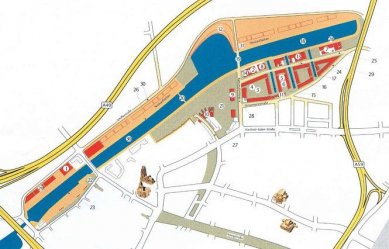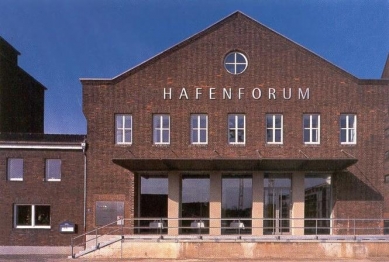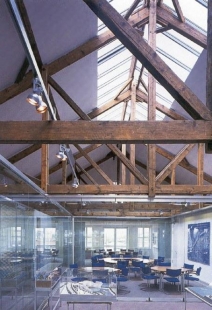
Inner Harbor

Duisburg was a very active participant in the industrial revolution in Germany in the second half of the 19th century. The proximity of the Rhine and thus the possibility of shipping to the whole world gave rise to the Duisburg phenomenon - an inland port. Innenhafen is basically an artificial dead arm of the Rhine. Warehouses and transshipment points quickly grew up on the banks of Innenhafen, and at the turn of the century, a train station was also established. Therefore, Innenhafen became an important transportation hub in the Rhineland.
A hundred years later, primarily due to changes in primary production and the ratio of labor volume in the primary and tertiary sectors, Innenhafen was in a dilapidated state. Abandoned warehouses, ecologically devastated river arm, in short, a classic industrial zone at the turn of the century. The Duisburg city council faced a significant task of regenerating the entire area and creating a contemporary modern part of the city. According to impressions from the site, it is evident that they succeeded.
The main urban planning plan for the reconstruction and development of the area was developed by the London office Foster & Partners. As is often the case in such situations, it also became the author of many buildings in the area, primarily the central building of the complex - Hafenforum. Through a sensitive reconstruction of the warehouse, a modern administrative building was created, where models and plans for the future Innenhafen are now displayed. Foster is also the author of the new harbor pier and part of the residential buildings in the complex. Today, Innenhafen includes the already famous Küppersmühle, which houses the Groth collection of modern art, a Jewish center designed by Zvi Heckler, the Kontorhaus administration (Brun, Voigt und Partner - 1995), residential building complexes (Foster & Partners; Auer + Weber; Ingenhoven Overdiek, Kahlen & Partner), a senior citizens' home, a kindergarten, a "park of remembrance," and a series of administrative and production buildings creating jobs in the area.
The crowning feature of the entire project is the so-called Eurogate, designed by none other than Sir Norman Foster. It is a massive administrative building that fills the largest bay of Innenhafen very well. The maximalist ecological concept of the building, modern intelligent materials, and sci-fi expression of the structure correspond to the current mood in Norman Foster's London studio. So far, Eurogate presents itself as a pure utopia; however, observing the success of the buildings that have been realized so far, we cannot yet throw in the towel.
A hundred years later, primarily due to changes in primary production and the ratio of labor volume in the primary and tertiary sectors, Innenhafen was in a dilapidated state. Abandoned warehouses, ecologically devastated river arm, in short, a classic industrial zone at the turn of the century. The Duisburg city council faced a significant task of regenerating the entire area and creating a contemporary modern part of the city. According to impressions from the site, it is evident that they succeeded.
The main urban planning plan for the reconstruction and development of the area was developed by the London office Foster & Partners. As is often the case in such situations, it also became the author of many buildings in the area, primarily the central building of the complex - Hafenforum. Through a sensitive reconstruction of the warehouse, a modern administrative building was created, where models and plans for the future Innenhafen are now displayed. Foster is also the author of the new harbor pier and part of the residential buildings in the complex. Today, Innenhafen includes the already famous Küppersmühle, which houses the Groth collection of modern art, a Jewish center designed by Zvi Heckler, the Kontorhaus administration (Brun, Voigt und Partner - 1995), residential building complexes (Foster & Partners; Auer + Weber; Ingenhoven Overdiek, Kahlen & Partner), a senior citizens' home, a kindergarten, a "park of remembrance," and a series of administrative and production buildings creating jobs in the area.
The crowning feature of the entire project is the so-called Eurogate, designed by none other than Sir Norman Foster. It is a massive administrative building that fills the largest bay of Innenhafen very well. The maximalist ecological concept of the building, modern intelligent materials, and sci-fi expression of the structure correspond to the current mood in Norman Foster's London studio. So far, Eurogate presents itself as a pure utopia; however, observing the success of the buildings that have been realized so far, we cannot yet throw in the towel.
The English translation is powered by AI tool. Switch to Czech to view the original text source.
0 comments
add comment

















